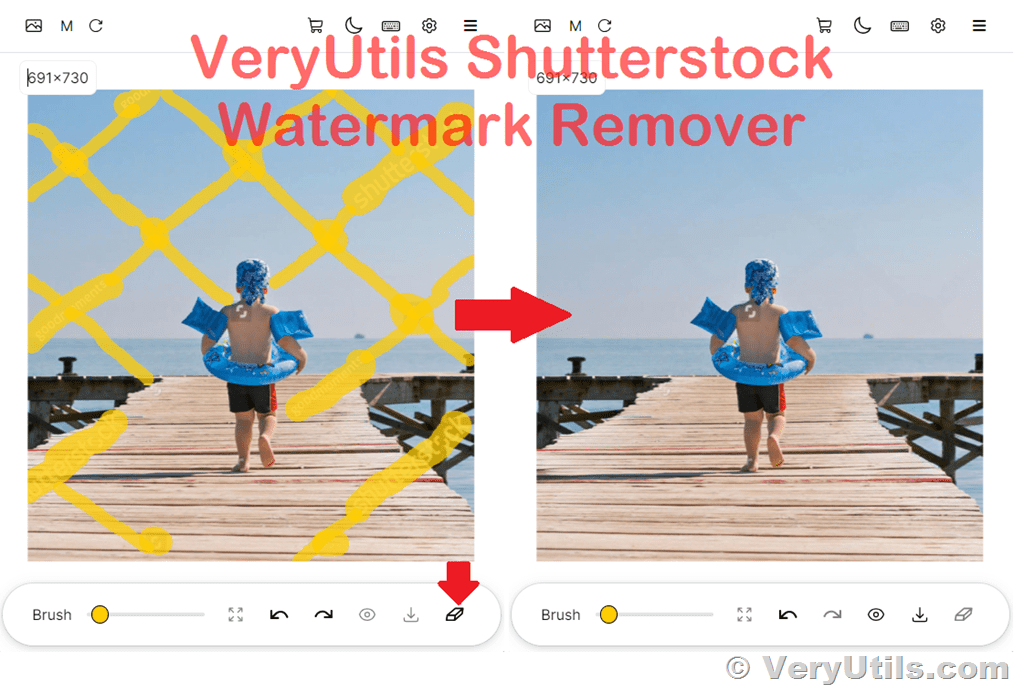Ever come across a stunning Shutterstock image, only to be greeted by that unmistakable watermark across the photo? Watermarks are those semi-transparent overlays featuring the Shutterstock logo or text that appear on images before purchase or licensing. Their main purpose? To protect the photographer’s and
Legal Considerations When Removing Watermarks from Shutterstock Images

Before you even think about removing a watermark from a Shutterstock image, it’s crucial to understand the legal landscape. Watermarks are there for a reason—they denote ownership and licensing rights. Removing or attempting to remove watermarks without proper authorization is considered copyright infringement and can lead to serious legal consequences, including fines or lawsuits. If you want to use an image without the watermark, the right way is to purchase a license or obtain explicit permission from the rights holder. Remember, just because you find a workaround online doesn’t mean it’s legal or ethical. Respecting intellectual property rights not only keeps you out of trouble but also supports photographers and creators who work hard to produce stunning images. Always ensure you have the proper licensing before using or editing watermarked images, and if in doubt, consult legal advice or Shutterstock’s licensing policies. Doing things the right way not only keeps you compliant but also fosters a fair creative community for everyone involved.
3. Best Practices for Watermark Removal
Removing watermarks from images, especially those from Shutterstock or similar platforms, can be a delicate process. It’s important to approach this task with care, respecting copyright laws and the rights of content creators. That said, if you’re working on your own images or have permission to modify certain images, here are some best practices to keep in mind.
Understand the Purpose and Legal Implications
Before you dive into watermark removal, ask yourself—why are you doing this? If the image is copyrighted, ensure you have the right to modify it. Unauthorized removal of watermarks can lead to legal issues, so always play it safe and use images within their licensing terms.
Use the Right Tools for the Job
Not all watermark removal methods are created equal. Some techniques might leave visible marks or distort the image, while others can do a cleaner job. Choose tools that are designed for this purpose or that have features for content-aware editing.
Maintain Image Quality
When removing watermarks, aim to preserve the original quality and details of the image. Over-aggressive editing can lead to loss of sharpness, color inconsistencies, or unnatural-looking spots. Use high-resolution images whenever possible for better results.
Work Step-by-Step
- Zoom in on the watermark area for precision.
- Select appropriate editing tools—clone stamp, healing brush, or content-aware fill.
- Carefully blend the edited area with the surrounding pixels.
- Compare before and after to ensure a seamless look.
- Make minor adjustments if needed for color and texture consistency.
Practice and Patience Are Key
Watermark removal can be tricky, especially if the watermark covers a detailed or complex part of the image. Practice on copies of your images and take your time to achieve the best results. Rushing often leads to subpar edits or visible traces of the watermark.
Remember, the goal is to make the watermark disappear naturally without compromising the image’s integrity. With these best practices, you’ll be better equipped to handle watermark removal responsibly and effectively.
4. Top Tools and Software for Watermark Removal
When it comes to removing watermarks from Shutterstock images, choosing the right tool can make all the difference. There are numerous options on the market, ranging from simple apps to advanced photo editing software. Here’s a rundown of some of the best tools to help you get the job done efficiently and cleanly.
1. Adobe Photoshop
Arguably the most popular photo editing software, Photoshop offers powerful features like the Content-Aware Fill and the Clone Stamp Tool. These allow for precise removal of watermarks by intelligently filling in the area based on surrounding pixels. While it has a learning curve, mastering these tools can produce professional results.
2. GIMP (GNU Image Manipulation Program)
This free, open-source alternative to Photoshop is quite capable of watermark removal. GIMP includes tools like the Healing Tool and Clone Tool, which can help blend the watermark area with the background. It’s a great choice for users who want powerful editing features without the cost.
3. Inpaint
Inpaint specializes in removing unwanted objects, including watermarks, with a simple interface. You just highlight the watermark, and the software intelligently fills in the area. It’s fast and user-friendly, making it ideal for quick edits without deep technical skills.
4. HitPaw Watermark Remover
This dedicated tool is designed specifically for removing watermarks from images and videos. It uses AI algorithms to identify and erase watermarks seamlessly. It’s straightforward to use and offers batch processing options for multiple images.
5. Photopea
An online editor that mimics Photoshop’s interface. It offers tools like the Clone Stamp and Healing Brush, which can be used directly in your browser without installing software. Perfect for quick edits on the go.
6. Topaz Mask AI
For more advanced users, Topaz Mask AI offers AI-powered masking and content-aware removal capabilities. It’s particularly useful when dealing with complex backgrounds or intricate watermarks.
Final Tips:
- Always work on a duplicate of your original image to prevent accidental data loss.
- Combine tools if necessary—use Photoshop’s Content-Aware Fill for large areas and clone tools for fine-tuning.
- Test different tools to see which one gives the best results for your specific image.
With the right combination of tools and techniques, watermark removal can become a manageable task, helping you restore images to their original beauty or prepare them for legitimate use. Remember, responsible editing and respecting copyright laws always come first!
5. Step-by-Step Guide to Removing Watermarks Safely and Ethically
Removing watermarks from images can be a tricky topic, and it’s important to approach this process with both safety and ethics in mind. Watermarks are there for a reason—usually to protect the creator’s rights and ensure they get credit for their work. So, before you proceed, make sure you have the proper rights or permissions to use the image without the watermark.
That said, if you’re working with images you own or have explicit permission to edit, here’s a clear, step-by-step guide to removing watermarks safely and ethically:
- Obtain the Original Image: Always start with the original, high-resolution image. If you purchased or licensed it, download the unwatermarked version from Shutterstock or the source.
- Choose the Right Tools: Use reputable photo editing software like Adobe Photoshop, GIMP, or specialized watermark removal tools. Avoid shady online services that might compromise your security or deliver poor results.
- Make a Backup: Before editing, save a copy of the original. This way, you can always revert if something doesn’t go as planned.
- Use Content-Aware Fill or Clone Stamp: In Photoshop, the Content-Aware Fill feature is a powerful way to remove watermarks seamlessly. Alternatively, the Clone Stamp tool allows you to carefully paint over the watermark, sampling nearby pixels to blend the area naturally.
- Zoom In for Precision: Work at high zoom levels to accurately select and remove the watermark without affecting the surrounding details.
- Refine Your Edits: After removing the watermark, use tools like Healing Brush or Smudge Tool to smooth out any irregularities and make the area blend with the rest of the image.
- Check the Result: Step back and view the image at its intended size. Make any necessary adjustments for a seamless look.
- Save Your Work: Save the edited, watermark-free version in a high-quality format. Keep your layered file if you might need further edits later.
Remember, the goal is to maintain the integrity of the image while removing the watermark. Patience and attention to detail are key. And always, always respect copyright laws—use watermarked images only if you have the rights, or opt for licensed, watermark-free images from Shutterstock or other stock photo providers.
6. Tips to Avoid Watermark Removal Issues and Protect Your Content
Dealing with watermarks can be frustrating, especially if it’s accidental or if you’re concerned about legal issues. The best approach is to prevent problems before they happen. Here are some handy tips to help you avoid watermark removal issues and keep your content safe and compliant:
- Always Use Licensed Images: The simplest way to avoid watermark trouble is to purchase or license images legally. Shutterstock offers a variety of plans and licenses that give you access to high-quality, watermark-free images.
- Download Watermark-Free Versions: After purchasing or licensing, ensure you download the high-resolution, watermark-free image directly from the platform. Keep these files organized and backed up.
- Pay Attention to Licensing Terms: Read and understand the licensing agreements. Some licenses restrict modifications, while others allow extensive edits. Knowing this helps you stay compliant.
- Use Watermark-Free Stock Libraries: Besides Shutterstock, consider other reputable sources like Unsplash, Pexels, or Adobe Stock, which provide free or paid images without watermarks, legally and safely.
- Implement Proper Attribution: If the license requires attribution, always give credit to the creator. This not only respects their rights but also keeps you legally protected.
- Employ Watermark Detection Tools: If you suspect someone might have used your images without permission, use tools like Google Reverse Image Search or TinEye to track unauthorized use.
- Educate Your Team: If you work with a team or clients, make sure everyone understands copyright laws and the importance of using licensed content. Clear policies can prevent accidental misuse.
- Secure Your Content: Use digital rights management (DRM) tools or watermark your own images with your branding to deter unauthorized removal or use.
By following these tips, you can significantly reduce the risk of encountering watermark removal issues and ensure your content remains protected and legally compliant. Remember, respecting copyright not only keeps you out of legal trouble but also supports the hardworking creators behind the images you love to use.
7. Alternatives to Watermark Removal for Licensed Shutterstock Images
If you’re looking to use Shutterstock images without worrying about watermarks, the best approach is to go through the proper licensing channels. Removing watermarks from images you haven’t purchased or licensed is not only unethical but also illegal. Here are some legitimate alternatives to watermark removal that ensure you’re respecting content creators and avoiding legal issues:
Purchase the Proper License
The most straightforward way to get high-quality, watermark-free images is to buy the appropriate license directly from Shutterstock. Depending on your needs, you can choose from various licensing options:
- Standard License: Suitable for most commercial uses, including digital and print media.
- Enhanced License: For large-scale campaigns, merchandise, or products for resale.
Once you’ve purchased your license, you’ll receive a download link for the high-resolution, watermark-free version of the image. This not only ensures legal compliance but also gives you access to the best quality images for your project.
Use Shutterstock’s Subscription or Credit Packages
If you frequently use Shutterstock images, subscribing or purchasing credits can be cost-effective options. These plans provide access to a wide range of images with clear licensing, eliminating the need for watermark removal altogether. Plus, you get the convenience of downloading multiple images quickly and legally.
Explore Shutterstock’s Free Resources
Shutterstock occasionally offers free images for download, which come without watermarks. While the selection may be limited, these can be great for small projects or testing purposes. Always check the licensing terms to ensure you’re complying with usage rights.
Consider Alternative Stock Image Sites
If licensing costs are a concern, there are other platforms that offer free or more affordable images with clear licensing. Websites like Unsplash, Pexels, and Pixabay provide high-quality images under licenses that often allow commercial use without attribution. Just make sure to read and follow their licensing requirements.
Why Not Remove Watermarks Legally?
While it might seem tempting to remove watermarks from images you find online, doing so without permission can lead to serious legal consequences, including lawsuits and fines. Respect for content creators’ rights is vital, and using images legally not only keeps you safe but also supports photographers and artists who produce these valuable resources.
8. Conclusion and Final Recommendations for Using Shutterstock Images Without Watermarks
Using Shutterstock images without watermarks in your projects is completely doable—and legally safe—when you follow the right steps. The key takeaways are:
- Always purchase the correct license: Whether through subscription, credit packs, or individual downloads, make sure you have the legal right to use the image.
- Use official channels: Download images directly from Shutterstock or authorized platforms to ensure quality and legality.
- Respect licensing terms: Different images come with different usage rights; always read and adhere to these terms.
- Consider free or alternative resources: For budget-friendly options, explore platforms like Unsplash or Pexels that offer free images with permissive licenses.
Remember, the effort and investment in licensing not only protect you legally but also support the talented photographers and artists behind these images. If you need high-quality visuals for your project, always opt for legitimate sources and proper licensing. It’s the best way to ensure your work remains professional, ethical, and legally compliant.

